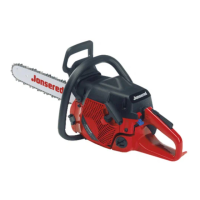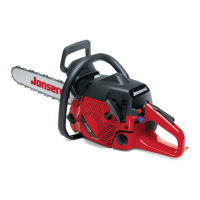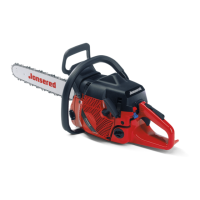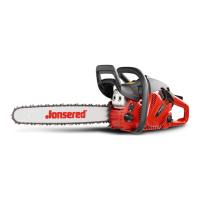Do you have a question about the Jonsered CS 2152 EPA II and is the answer not in the manual?
Explains symbols displayed on the chain saw itself for safety and operation.
Details the meaning of various symbols used within the operator's manual.
A welcome message to the customer, encouraging satisfaction and long-term use of the product.
Identifies and labels the various parts and components of the chain saw.
Essential checks and information required before operating a new chain saw for the first time.
Crucial safety guidelines regarding machine use, maintenance, and personal protective equipment.
Lists and describes the necessary personal protective gear for safe chain saw operation.
Explains the function and importance of the built-in safety features of the chain saw.
Details how the chain brake functions, its activation mechanisms, and its role in preventing kickback.
Explains how hand activation and inertia of the chain brake work, and limitations in kickback protection.
Covers muffler safety, spark arrestors, and basic rules for maintaining cutting equipment.
Discusses how cutting equipment reduces kickback, bar types, chain types, and terms defining them.
Provides instructions and advice on sharpening cutting teeth and adjusting the depth gauge for optimal performance.
Details the process for adjusting the depth gauge and tensioning the saw chain correctly.
Covers filling with chain oil, checking lubrication, drive sprocket details, and needle bearing lubrication.
Outlines regular checks for bar wear, general safety practices, and confirming safety features are functional.
Step-by-step instructions for correctly fitting the guide bar and saw chain to the machine.
Information on gasoline types, two-stroke oil, and the correct mixing ratios for fuel.
Guidelines for safe fueling, transport, storage, and general fuel safety precautions.
Details the steps for starting the chain saw's engine, including choke and decompression valve usage.
Explains how to safely stop the engine and general precautions during operation.
Outlines essential checks before use and fundamental safety rules for operating the chain saw.
Provides general guidance for safe operation, body positioning, and hazard awareness.
Provides general rules for safe operation, grip, and avoiding kickback through technique.
Covers fundamental cutting methods, defining terms like cutting, limbing, and splitting.
Instructs on how to safely cut logs based on their support and risk of jamming or splitting.
Guides on determining felling direction, clearing the area, and making directional cuts for controlled felling.
Details how to make the felling cut and the importance of the felling hinge for controlling fall direction.
Provides methods for safely freeing trapped trees and cutting branches under tension.
Explains the cause of kickback and provides detailed guidance on how to prevent it during operation.
Outlines general maintenance responsibilities and detailed steps for carburetor adjustment.
Details checks for the chain brake, front hand guard, and inertia brake release mechanisms.
Inspects the chain catcher, right hand guard, vibration damping system, and stop switch for proper function.
Instructions for inspecting and maintaining the muffler, and replacing starter cords.
Covers tensioning recoil springs, changing starter cords, fitting starters, and air filter maintenance.
Details spark plug checks, bar tip sprocket lubrication, needle bearing lubrication, and oil pump adjustment.
Explains air injection cleaning, measures for winter use, and heated handle/carburetor features.
Provides a schedule for daily, weekly, and monthly maintenance tasks for the chain saw.
Lists technical specifications for the engine, ignition, and fuel/lubrication systems.
Details recommended bar and chain combinations and saw chain filing specifications.
Explains the owner's warranty rights, responsibilities, and the coverage provided for emission-related parts.
Summarizes kickback safety and provides additional general safety measures for chain saw users.
Explains symbols displayed on the chain saw itself for safety and operation.
Details the meaning of various symbols used within the operator's manual.
A welcome message to the customer, encouraging satisfaction and long-term use of the product.
Identifies and labels the various parts and components of the chain saw.
Essential checks and information required before operating a new chain saw for the first time.
Crucial safety guidelines regarding machine use, maintenance, and personal protective equipment.
Lists and describes the necessary personal protective gear for safe chain saw operation.
Explains the function and importance of the built-in safety features of the chain saw.
Details how the chain brake functions, its activation mechanisms, and its role in preventing kickback.
Explains how hand activation and inertia of the chain brake work, and limitations in kickback protection.
Covers muffler safety, spark arrestors, and basic rules for maintaining cutting equipment.
Discusses how cutting equipment reduces kickback, bar types, chain types, and terms defining them.
Provides instructions and advice on sharpening cutting teeth and adjusting the depth gauge for optimal performance.
Details the process for adjusting the depth gauge and tensioning the saw chain correctly.
Covers filling with chain oil, checking lubrication, drive sprocket details, and needle bearing lubrication.
Outlines regular checks for bar wear, general safety practices, and confirming safety features are functional.
Step-by-step instructions for correctly fitting the guide bar and saw chain to the machine.
Information on gasoline types, two-stroke oil, and the correct mixing ratios for fuel.
Guidelines for safe fueling, transport, storage, and general fuel safety precautions.
Details the steps for starting the chain saw's engine, including choke and decompression valve usage.
Explains how to safely stop the engine and general precautions during operation.
Outlines essential checks before use and fundamental safety rules for operating the chain saw.
Provides general guidance for safe operation, body positioning, and hazard awareness.
Provides general rules for safe operation, grip, and avoiding kickback through technique.
Covers fundamental cutting methods, defining terms like cutting, limbing, and splitting.
Instructs on how to safely cut logs based on their support and risk of jamming or splitting.
Guides on determining felling direction, clearing the area, and making directional cuts for controlled felling.
Details how to make the felling cut and the importance of the felling hinge for controlling fall direction.
Provides methods for safely freeing trapped trees and cutting branches under tension.
Explains the cause of kickback and provides detailed guidance on how to prevent it during operation.
Outlines general maintenance responsibilities and detailed steps for carburetor adjustment.
Details checks for the chain brake, front hand guard, and inertia brake release mechanisms.
Inspects the chain catcher, right hand guard, vibration damping system, and stop switch for proper function.
Instructions for inspecting and maintaining the muffler, and replacing starter cords.
Covers tensioning recoil springs, changing starter cords, fitting starters, and air filter maintenance.
Details spark plug checks, bar tip sprocket lubrication, needle bearing lubrication, and oil pump adjustment.
Explains air injection cleaning, measures for winter use, and heated handle/carburetor features.
Provides a schedule for daily, weekly, and monthly maintenance tasks for the chain saw.
Lists technical specifications for the engine, ignition, and fuel/lubrication systems.
Details recommended bar and chain combinations and saw chain filing specifications.
Explains the owner's warranty rights, responsibilities, and the coverage provided for emission-related parts.
Summarizes kickback safety and provides additional general safety measures for chain saw users.











